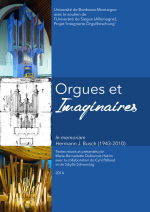
Orgues et Imaginaires In memoriam Hermann J. Busch
Université de Bordeaux-Montaigne avec le soutien de l'Université de Siegen (Allemagne), Projet 'Integrierte Orgelforschung':
Textes réunis et présentés par Marie-Bernadette Dufourcet-Hakim avec la collaboration de Cyril Pallaud et de Sibylle Schwantag - Presses Universitaires de Bordeaux, 2015, 300p.,
ISBN 978-2-86-781-933-9
L'orgue constitue un des piliers de notre patrimoine occidental qui fascine. Très présent dans la culture occidentale depuis au moins le XIIIe siècle, il en est de fait un marqueur identitaire fort. Traditionnellement associé à l'architecture religieuse et aux pratiques cultuelles des chrétiens, il participe à la fonction sacrée sur les plans musical et aussi visuel par sa contribution décorative, parfois édifiante voire militante. A partir du XVIIIe siècle, avec le développement des concerts publics, l'orgue s'est peu à peu intégré à de nombreuses salles de concert puis, au XXe siècle, à des cinémas à l'époque du muet. De nombreux campus universitaires sont également dotés d'un grand orgue, en Europe du Nord, aux Etats-Unis, au Japon ou en Corée. Ainsi, selon les lieux et les circonstances, instrument religieux ou profane, de structure et de taille variables, il s'est diffusé partout dans le monde. Loin d'être un objet de recherche réducteur réservé à une élite d'initiés, il est fondamentalement un objet pluridisciplinaire, à la fois ouvrage technique, instrument de musique et objet d'art, exemplaire des liens entre art et militantisme religieux, entre politique et religion, entre univers social religieux et profane.
A la suite des Etats-Unis, des institutions d’envergure se sont développées depuis plusieurs décennies chez nos voisins européens, certaines ayant un rayonnement international reconnu comme la Walcker-Stiftung für orgelwissenschaftliche Forschung, l'Institut für Orgel, Orgelforschung und Kirchenmusik de Vienne, the Royal College of Organists de Londres, le Fraunhofer Institut de Stuttgart, le département de musicologie de l'Université de Genève, et bien sûr le GOArt (Göteborg Organ Art Center). En revanche, malgré la présence de parcs organistiques de grande valeur notamment en Alsace, il n'existe rien d'équivalent dans le paysage universitaire français.
Succédant aux précédents colloques tenus à l'université de Bordeaux-Montaigne sur le facteur Dom Bedos de Celles, la réflexion collective internationale et pluridisciplinaire menée ici questionne l'objet en dégageant les perspectives possibles de recherche sur le plan de la facture, de l'architecture, des musiciens et de la musique. Elle pose un nouveau jalon intégrant les multiples facettes de l'orgue, dans la ligne conceptuelle de l'Integrierte Orgelforschung élaborée par le Pr. Busch à qui nous dédions avec une reconnaissance sincère ce travail.
|
The organ constitutes one of the pillars of our western heritage which fascinates. Very present in the western culture from at least the 13th
century, it is de facto a strong identity marker. Traditionally associated with the religious architecture and with the religious Christian practice, the organ participates in the sacred
office both on the visual and musical plans by its ornamental contribution, sometimes edifying, even militant. From the 18th century, with the development of the public concerts, the organ integrates
little by little numerous concert halls, then cinemas in the 20th century, at the time of silent movies. Many universities owns also a great organ, mostly in the Northern Europe, the United
States, Japan, Korea or China. According to places and circumstances, this instrument may be thus religious or profane, of variable structure and size, and as such it pervades many places all around
the world. Far from being a small-scale matter of research for just an initiated elite, it is fundamentally a multidisciplinary object, pertaining at the same time to technical work, musical
instruments and work of art, model of the links between art and religious militancy, politics and religion, profane and religious social worlds.
|


